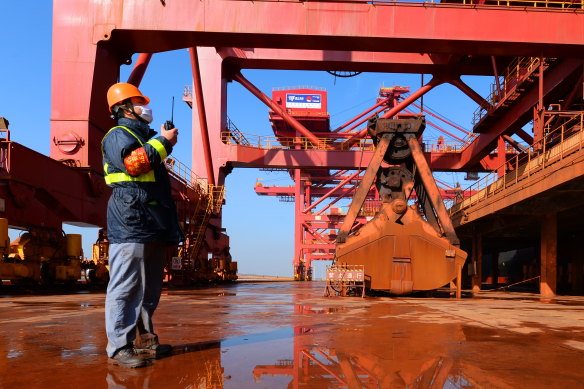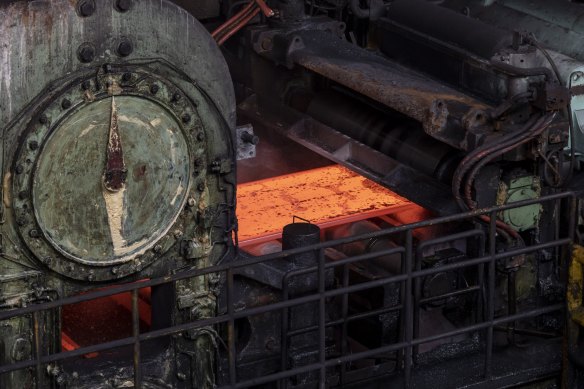This was published 9 months ago
Opinion
Iron ore slump shows that China’s deflation risk is rising
Stephen Bartholomeusz
Senior business columnistIf the iron ore price is a barometer of the health of China’s economy, then it is signalling a level of weakness that ought to galvanise China’s policymakers – but it has yet to do so.
On Monday, the iron ore price sank below $US90 a tonne for the first time in nearly two years. A week ago, it was just above $US100 a tonne. At the start of this year, it was above $US140 a tonne.
China’s steel industry, which accounts for about 57 per cent of global production, is experiencing weak domestic and external demand, proliferating trade barriers and consequent over-capacity. However, it’s not the only sector within China that’s showing signs of stress.

A ship unloader at Taicang port unloading iron ore imported from Australia, Brazil and other countries. Prices for the metal have been sinking amid lower demand from China.Credit: Getty
Last week, former People’s Bank of China governor Yi Gang urged policymakers to focus on fighting deflationary pressures within the economy, which he said faces weak domestic demand and needs proactive fiscal policy and accommodative monetary policy.
This week’s release of China’s inflation data tends to reinforce Yi’s message. China does have a deflation problem.
At a headline level, the numbers didn’t look that bad. The consumer price index rose 0.6 per cent, year-on-year, slightly faster than July’s 0.5 per cent increase.
The August CPI was, however, boosted by a 2.8 per cent increase in food prices. The price of fresh vegetables, for instance, was up nearly 22 per cent, and pork was up 16.1 per cent, with record heat and rainfall severely impacting supplies.
Non-food inflation was only 0.2 per cent (year-on-year), the lowest reading since July last year. Core inflation, which excludes volatile food and energy prices, rose only 0.3 per cent, its smallest increase since March 2021.
Industrial producer prices – factory gate prices – fell 1.8 per cent in August, compared with a 0.8 per cent decline in July. That’s the 23rd consecutive month in which producer prices have fallen.
The inflation numbers depict a stalling economy on the brink of deflation, where consumers defer purchases expecting prices to continue falling. That would flow into lower economic growth, reduced corporate profits, less investment, fewer jobs and greater corporate financial stress.
[China’s] inflation numbers depict a stalling economy on the brink of deflation, where consumers defer purchases in expectation that prices will continue to fall.
The origins of this period of disinflation in China’s economy lie with the continuing collapse of its property sector, now into its third year. That has weighed heavily on households and their spending, with consumer confidence surveys producing near-record-low readings. Most of China’s household wealth is exposed to the property market.
Bank lending (excluding interbank loans) has been contracting for the first time in almost two decades despite several interest rate cuts by the central bank that have targeted mortgages.
The implosion in the property sector has also heavily impacted the local government sector, which had relied on income from property sales for a significant proportion of revenues.
Those local governments, via which much of China’s social spending is funnelled even though the central government raises most of the government revenues, are overly leveraged.
Beijing has promised to help them reduce debt and said it will give them the scope to raise funds more directly, but to date, nothing of substance seems to have been done, which would also be weighing on levels of economic activity and consumer finances and confidence.
The impact of the heavy falls in property prices and property-related activity has been compounded by strategic decisions made in Beijing.
Xi Jinping has resisted calls from within and outside China to respond to the weakness of domestic demand with a substantial stimulus package. So far, any efforts to boost consumption have been modest and piecemeal.
Instead, China has doubled up on an export-led strategy as part of its latest five-year plan to dominate advanced manufacturing and other high-tech sectors.
The investment and subsidies being poured into sectors like electric vehicles, green technologies, artificial intelligence and aviation are partly driven by geopolitical ambition, but also by a desire to protect China’s economy from increasing global protectionism. Xi wants to shore up China’s capabilities and supply chains.
Unfortunately, over-investment during a period of weak domestic demand has resulted in substantial over-capacity in key sectors like the steel industry, or EVs and solar.
That excess capacity has been pushed into export markets, with rising volumes and falling prices producing a backlash within China’s export markets that has seen trade barriers raised and more threatened.
The widespread problem of production and supply outstripping demand is generating deflationary pressures within the economy. It is now rippling through the global economy and markets even as the US economy appears to slow and Europe’s growth remains tepid.
It is not just iron ore prices that have fallen – the copper price is down about 4 per cent over the past month and oil prices have slumped more than 12 per cent – but the steel industry is at the heart of China’s industrial base.

The hot-rolling workshop at Baowu Steel’s production facility in Shanghai. The head of China Baowu said the industry faced a situation worse than the crises it experienced in 2008 and 2015.Credit: Bloomberg
Last month, the head of China Baowu Steel Group, the world’s biggest steelmaker, said the industry faced a situation worse than the crises it experienced in 2008 and 2015.
The collapse in property-related activity – new construction starts have been running close to 25 per cent below last year’s already-depressed levels – the lack of large-scale infrastructure investment and the over-capacity issues within China’s factories are having a concentrated impact on the steelmakers, with a flow-on effect for their demand for iron ore.
The longer the period of deflation within China’s industrial base continues, the more difficult and expensive it will be to try to turn it around.
China can avoid the deflationary spiral Japan was trapped into in the 1990s and the decades of economic stagnation that followed. However, that would require a substantial and probably painful rationalisation of its industrial base to drive out the excess capacity, and a significant program of stimulus directed at households.
With Donald Trump, who seems to think tariffs can solve almost any economic issue, an even-money chance to regain the White House, China’s already-pressured export-led strategy could face another broader and harsher bout of global protectionism.
That prospect would be chilling, not just for China and countries in the region like Australia that feed off its growth, but for the rest of the world.
Trump either doesn’t understand (most likely) or deliberately misstates how tariffs work.
The rest of the world knows that contrary to what Trump has said, trade wars aren’t good, aren’t easy to win and, indeed, that no one wins from them. And because of its over-exposure to global trade, that’s especially the case for China.
The Market Recap newsletter is a wrap of the day’s trading. Get it each weekday afternoon.